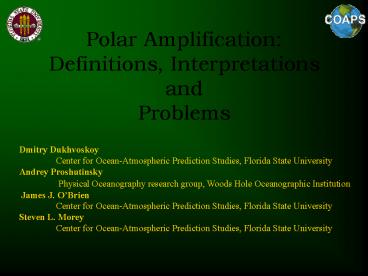Polar Amplification: Definitions, Interpretations - PowerPoint PPT Presentation
1 / 29
Title:
Polar Amplification: Definitions, Interpretations
Description:
High covariance inflates the variance of the estimate ... The variance is inflated by covariance. Data separation distance. X(1) X(2) X(3) ... – PowerPoint PPT presentation
Number of Views:53
Avg rating:3.0/5.0
Title: Polar Amplification: Definitions, Interpretations
1
Polar Amplification Definitions, Interpretations
and Problems
Dmitry Dukhvoskoy Center for
Ocean-Atmospheric Prediction Studies, Florida
State University Andrey Proshutinsky Physical
Oceanography research group, Woods Hole
Oceanographic Institution James J. OBrien
Center for Ocean-Atmospheric Prediction Studies,
Florida State University Steven L. Morey
Center for Ocean-Atmospheric Prediction Studies,
Florida State University
2
Outline
I. Overview of Polar Amplification phenomenon 1.
Model-based definition Amplification of a
long-term variability 2. Observation-based
(original) definition Amplification of
interannual variability II. Discussion on
spatial averaging and Polar Amplification 1.
Problems in Polar Amplification 2. Zonal
averaging and bias in temporal variability of the
estimates
3
Two definitions of Polar Amplification
Results of GCM simulations of SAT under increased
CO2 scenarios reveal amplified warming in high
latitudes (Manabe, S., and R.J. Stouffer, 1980)
Statistical analysis of observations shows
amplification with latitude of interannual
variability of Northern hemispheric SAT
(Rubinstein, E.S., 1970)
4
Polar Amplification in a GCM in Manabe and
Stouffer (1980) in 4xCO2 Experiment
Arctic region warming is larger and varies with
season
In low latitudes the warming is small
Latitude-time distribution of zonal mean
difference in SAT (?K) between the 4xCO2 and
1xCO2 experiment
5
Mechanism of Polar Amplification in GCMs
Positive ice-albedo feedback is a major reason of
the warming amplification (Manabe and Stouffer,
1980 Lemke, 2001)
Based on M. Holland website www.asp.ucar.edu/coll
oquium/holland.html
6
Problems in the Model-Based Definition
Sensitivity to Model Parameters
The increase in zonally averaged SAT for 2xCO2
conditions as a function of latitude normalized
by the globally averaged SAT increase.
From Holland and Bitz, Climate Dyn., 21, 2003
7
Problems in the Model-Based Definition Is it
Supported by Observations?
Arctic and northern-hemispheric air-temperature
trends during the 20th century are similar, and
do not support the predicted polar amplification
of global warming. Polyakov et al., J. Climate,
16, 2003
Arctic and northern-hemispheric SAT trends
ranging from a 17 year (1985-2001) to the full
record length (1875-2001), with 1 year increments
8
Second Definition of Polar Amplification
Polar Amplification is a phenomenon of poleward
increase of interannual variability of zonal
average of some meteorological characteristic
(SAT, sea level pressure, precipitation, cloud
cover) Zakharov, V.F., Sea ice
in the climate system, 1996
9
Polar Amplification from Empirical Data
Polar Amplification the variability increases
with latitude
Standard deviations of zonal average SAT vs
latitude for different months, 1898 - 1988
Based on Alekseev and Svyaschennikov (1991)
10
Comparison of Two Definitions of Polar
Amplification
- Common
- Based on zonal average of SAT
- Describe amplification of a perturbation in high
latitudes
- Different
- Time scales of variability
- Origin of the data (simulated vs empirical)
11
II. Problems in Polar Amplification
Discussion on zonal averaging and temporal
variabiltiy
12
Problems in Zonal Averaging Approach
1. Different land-ocean distribution affects data
variability and covariance structure
2. Different distances between neighboring grid
points result in different covariance of the data
Ratio of the areas
S1/S2cos?1/cos?2 ? 4
13
Land-Sea Distribution in the Zonal Bands and
Polar Amplification
Land/Sea Distribution in the bands
STD of zonal SAT
The SAT fields have been acquired from NOAA-CIRES
Climate Diagnostic Center www.cdc.noaa.gov for
the period 1947-2003. The data have been
detrended prior to any analysis.
14
Spatial-Temporal Structure of the SAT Fields
Zero-lag Correlations for January in the Zonal
Bands
15
Spherical Grid with Normally Oriented Poles
Annual SAT, 1948
Zonal SAT and its Variability
16
Spherical Grid with Shifted Poles
Zonal SAT and its Variability
Annual SAT, 1948
Amplification at the new poles
17
Why is Covariance Structure Important in Zonal
Averaging?
18
Zonal Averaging
For discrete data in a regular grid
19
Variance of Zonal Average
Zero-lag covariance between a pair of gridded data
If
then
High covariance inflates the variance of the
estimate
20
Effect of Covariance on the Temporal Variability
of an Average
Three spatial-temporal data sets with the same
variance (?216) are generated with different
covariance structure
Zero-lag correlation
Variance of space-averages
The variance is inflated by covariance
21
Sum of Covariances of Zonal SATs
Latitudes
22
Is the Polar Amplification Explained by
Covariance?
Variance of zonal SAT
23
Sum of Covariances Correlation or Variability?
For two random variables
Sum of covariances is a complex function of
correlations of RVs and their STDs
How would this plot look if the variance of SAT
were the same?
24
Pure Effect of Covariance on Variability of Zonal
Average
Sum of covariances for zonal SAT from the gridded
data with equal variance
25
Adjusted Variance of Zonal SAT
where
Adjusted Variance
Not-adjusted Variance
26
Summary
Geophysical Aspect Phenomenon of Polar
Amplification is strongly related to the land/sea
distribution within the zonal bands. For the
zones with large sea areas, the data are
characterized by low interannual variability and
strong spatial correlation Statistical Aspect
Technique of zonal averaging introduces bias into
estimates of temporal variability of the averages
stemmed from covariance of the data The bias
results in a strongly decreased variance of the
zonal average SAT in the regions 70?N to 20?N
27
(No Transcript)
28
Correlograms of Zonal SAT
95 Significance Level
Data separation distance, h (km)
29
First Definition of Polar Amplification
In climate modeling studies the Polar
Amplification is viewed as the tendency for
simulated temperature changes to be larger at
high latitudes, as in the case of the warming
induced by increased greenhouse gases Glossary
of Meteorology, amsglossary.allenpress.com/glossar
y































